Last Friday (December 5, 2025), I filmed an extended discussion with my Kyoto University colleague,…
Australia – inflation rate falling fast, the RBA has overcooked it again
Today (October 30, 2024), the Australian Bureau of Statistics (ABS) released the latest – Consumer Price Index, Australia – for the September-quarter 2024. The data showed that the annual inflation rate rose by just 0.2 points in the quarter and has fallen to 2.9 per cent on an annual basis. The ABS also released the – Monthly Consumer Price Index Indicator – which considers movements in September alone and the annual September-to-September inflation rate was recorded as 2.1 per cent (down from 2.7 per cent in August), which means that the inflation rate is dropping fast and will soon be well below the lower bound of the RBA’s targetting range – which means the RBA has overcooked it again! The Monthly Indicator is less accurate though than the quarterly figure in that it contains less overall price information (less goods and services are surveyed). The major expectations series all show expected inflation to be in decline and well within the RBA’s target zone. Using the RBA’s own logic, interest rates should now be cut.
The summary, seasonally-adjusted Consumer Price Index results for the September-quarter 2024 are as follows:
- The All Groups CPI rose by 0.2 per cent for the quarter (steady) and 2.8 per cent over the 12 months (up from 3.6)
- The Trimmed mean series rose by 0.8 per cent for the quarter (down from 0.9) and 3.5 per cent over the previous year (down from 4.0 per cent).
- The Weighted median series rose by 0.9 per cent (up from 0.8 per cent) for the quarter and 3.8 per cent over the previous year (down from 4.2 per cent).
The ABS Media Release (October 30, 2024) – CPI rose 0.2% in the September 2024 quarter – noted that:
The Consumer Price Index (CPI) rose 0.2 per cent in the September 2024 quarter and 2.8 per cent annually …
The September quarter’s rise of 0.2 per cent is the lowest outcome since the June 2020 quarter fall which occurred during the COVID-19 outbreak and was driven by free childcare. …
Annually, the September quarter’s rise of 2.8 per cent was down from 3.8 per cent in the June quarter. This is the lowest annual inflation rate since the March 2021 quarter …
The most significant contributors to the quarterly rise of 0.2 per cent were Recreation and culture (+1.3 per cent) and Food and non-alcoholic beverages (+0.6 per cent).
Rises in prices for other goods and services were largely offset by falls in Electricity (-17.3 per cent) and Automotive fuel prices (-6.7 per cent) …
The 2024-25 Commonwealth Energy Bill Relief Fund rebates in all states and territories and state government electricity rebates in Queensland, Western Australia and Tasmania led to a large fall in electricity prices this quarter. Without the rebates, electricity prices would have increased 0.7 per cent this quarter …
Automotive fuel prices fell 6.7 per cent this quarter as lower global demand reduced the price of oil. This saw petrol prices fall in each of the past three months to reach their lowest level since the June 2023 quarter.
So a few observations:
1. The annual inflation rate continues to decline as the main drivers abate.
2. The Housing inflation has dropped from 5.2 per cent in the June-quarter to 2.8 per cent and is being driven largely by the rental component (6.7 per cent increase against 7.3 per cent in the June-quarter).
3. The rent inflation is, in part, due to tight supply (a combination of a ridiculously fast population growth spawned by much larger immigration numbers over the last year) and a failure by governments to invest in social housing over the last several decades.
5. However, given the tight supply, the rent increases have been being driven by the RBA’s own rate hikes as landlords in a tight housing market just pass on the higher borrowing costs – so the so-called inflation-fighting rate hikes were a significant force in driving inflation.
This graph shows that housing inflation peaked in the December-quarter 2022 and has been steadily declining ever since.
The slowdown in the economy as a result of the combined impacts of fiscal austerity and tight monetary policy has finally seen the rent inflation decline.
Trends in inflation
Over the 12 months to December the inflation rate was 2.9 per cent (down from 3.8).
The peak was in the December-quarter 2022 when the inflation rate high 7.8 per cent.
The following graph shows the quarterly inflation rate since the September-quarter 2005.
The next graph shows the annual headline inflation rate since the first-quarter 2002. The shaded area is the RBA’s so-called targetting range (but read below for an interpretation).
What is driving inflation in Australia?
The following bar chart compares the contributions to the quarterly change in the CPI for the September-quarter 2024 (blue bars) compared to the December-quarter 2023 (green bars).
Note that Utilities is a sub-group of Housing and are significantly impacted by government administrative decisions, which allow the privatised companies to push up prices each year, usually well in excess of CPI movements.
The impact of fiscal policy on that sub-group via the electricity rebates has obviously been significant, which goes to show that governments can moderate inflation through expansionary fiscal policy if the drivers are from the supply-side.
It also demonstrates that monetary policy is ineffective in dealing with this type of inflation.
One of the main drivers – Recreation and Culture – was due to the Spring travel boost.
The next graph shows the contributions in points to the annual inflation rate by the various components.
The ABS noted that:
Electricity prices fell 17.3 per cent in the September quarter and 15.8 per cent in the past 12 months.
The introduction of the 2024-25 Commonwealth Energy Bill Relief Fund (EBRF) rebates and State government rebates in Queensland, Western Australian and Tasmania from July drove the fall this quarter …
Excluding the rebates, electricity prices would have risen by 0.7 per cent in the September 2024 quarter.
The next graph is taken from the ABS and shows the impact of fiscal policy in reducing the inflation rate.
EBRF refers to the government’s Energy Bill Relief Fund.
Inflation and Expected Inflation
The following graph shows four measures of expected inflation produced by the RBA from the September-quarter 2005 to the September-quarter 2023.
The four measures are:
1. Market economists’ inflation expectations – 1-year ahead.
2. Market economists’ inflation expectations – 2-year ahead – so what they think inflation will be in 2 years time.
3. Break-even 10-year inflation rate – The average annual inflation rate implied by the difference between 10-year nominal bond yield and 10-year inflation indexed bond yield. This is a measure of the market sentiment to inflation risk. This is considered the most reliable indicator.
4. Union officials’ inflation expectations – 2-year ahead – this series hasn’t been updated since the September-quarter 2023.
Notwithstanding the systematic errors in the forecasts, the price expectations (as measured by these series) are now falling.
In the case of the Market economists’ inflation expectations and the Break-even 10-year inflation rate, the expectations remain well within the RBA’s inflation targetting range (2-3 per cent) and are declining.
The RBA has been claiming that inflation is not falling fast enough – and the longer it remains above the inflation targetting range, the more likely it is that a wage-price spiral and/or accelerating (unanchored) expectations will drive the rate up for longer.
Neither claim can be remotely justified given the data and was just cover for their policy mistakes.
Implications for monetary policy
What does this all mean for monetary policy?
The Consumer Price Index (CPI) is designed to reflect a broad basket of goods and services (the ‘regimen’) which are representative of the cost of living. You can learn more about the CPI regimen HERE.
The RBA’s formal inflation targeting rule aims to keep annual inflation rate (measured by the consumer price index) between 2 and 3 per cent over the medium term.
However, the RBA uses a range of measures to ascertain whether they believe there are persistent inflation threats.
Please read my blog post – Australian inflation trending down – lower oil prices and subdued economy – for a detailed discussion about the use of the headline rate of inflation and other analytical inflation measures.
The RBA does not rely on the ‘headline’ inflation rate. Instead, they use two measures of underlying inflation which attempt to net out the most volatile price movements.
The concept of underlying inflation is an attempt to separate the trend (“the persistent component of inflation) from the short-term fluctuations in prices. The main source of short-term ‘noise’ comes from “fluctuations in commodity markets and agricultural conditions, policy changes, or seasonal or infrequent price resetting”.
The RBA uses several different measures of underlying inflation which are generally categorised as ‘exclusion-based measures’ and ‘trimmed-mean measures’.
So, you can exclude “a particular set of volatile items – namely fruit, vegetables and automotive fuel” to get a better picture of the “persistent inflation pressures in the economy”. The main weaknesses with this method is that there can be “large temporary movements in components of the CPI that are not excluded” and volatile components can still be trending up (as in energy prices) or down.
The alternative trimmed-mean measures are popular among central bankers.
The authors say:
The trimmed-mean rate of inflation is defined as the average rate of inflation after “trimming” away a certain percentage of the distribution of price changes at both ends of that distribution. These measures are calculated by ordering the seasonally adjusted price changes for all CPI components in any period from lowest to highest, trimming away those that lie at the two outer edges of the distribution of price changes for that period, and then calculating an average inflation rate from the remaining set of price changes.
So you get some measure of central tendency not by exclusion but by giving lower weighting to volatile elements. Two trimmed measures are used by the RBA: (a) “the 15 per cent trimmed mean (which trims away the 15 per cent of items with both the smallest and largest price changes)”; and (b) “the weighted median (which is the price change at the 50th percentile by weight of the distribution of price changes)”.
So what has been happening with these different measures?
The following graph shows the three main inflation series published by the ABS since the September-quarter 2009 – the annual percentage change in the All items CPI (blue line); the annual changes in the weighted median (green line) and the trimmed mean (red line).
The latest data for the three measures shows:
1. The All Groups CPI rose by 0.2 per cent for the quarter and 2.9 per cent over the 12 months (down from 3.8 per cent last quarter).
2. The Trimmed mean series rose by 0.9 per cent for the quarter and 3.5 per cent over the previous year (down from 4 per cent).
3. The Weighted median series rose by 0.9 per cent for the quarter and 3.8 per cent over the previous year (down from 4.2 per cent).
How to we assess these results?
1. The RBA’s preferred measures remain outside the targetting range and they have been using that fact to justify their rate hikes since May 2022 even though the factors that have been driving the inflation until late 2022 were not sensitive to the interest rate increases.
However, the Monthly Price Indicator data mentioned in the introduction shows the Trimmed Mean has dropped from 3.8 per cent in July 2024 to 3.2 per cent in September 2024, and will decline further in the coming months.
2. The RBA also claimed the NAIRU was 4.25 per cent and with unemployment stable at around 3.9 per cent, they considered that justified further rate rises. However, if inflation is falling consistently with a stable unemployment rate then the NAIRU must be below the current rate of 3.9 per cent.
3. There is no evidence that inflationary expectations are accelerating – quite the opposite and that has been the case for some months now.
4. There is no significant wages pressure.
5. A major contributor to the current situation – rents – are, in part, being pushed up by the interest rate rises.
6. There is no justification for any further rate rises, especially given the slowdown in retail sales noted above.
Conclusion
The latest CPI data showed that the inflation rate is falling fast and looks likely to fall below the RBA’s inflation targetting range in the coming quarter.
That suggests that it is overshooting the RBA’s forecasts, which, in turn means that the policy settings by the RBA are wrong (using their own logic).
Once again it is looking like the RBA has made a monumental error in driving interest rates up so high, when the factors driving the inflation episode were not sensitive to those changes and were always going to abate on their own accord.
That is enough for today!
(c) Copyright 2024 William Mitchell. All Rights Reserved.
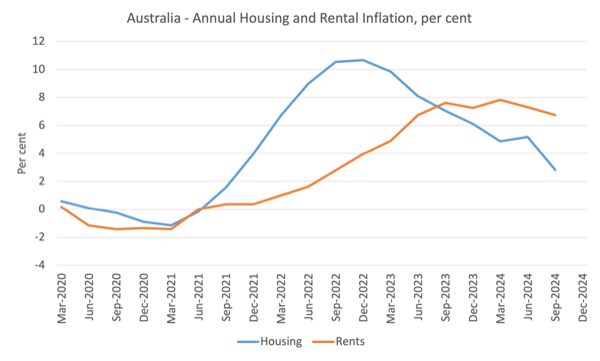
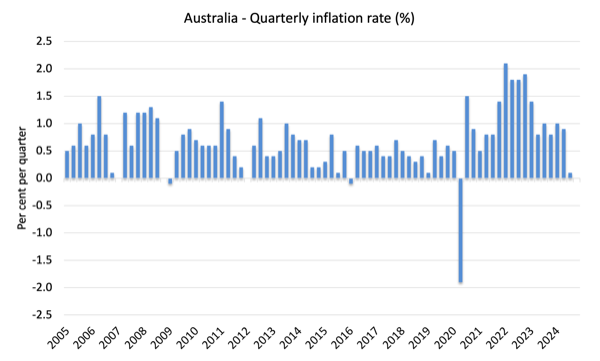
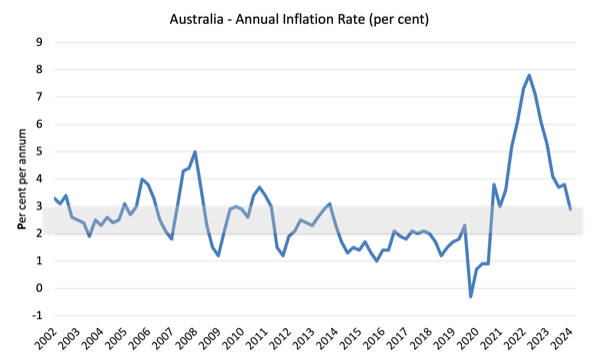
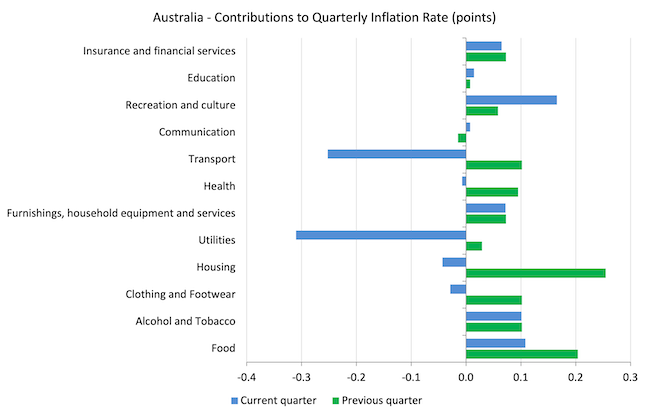
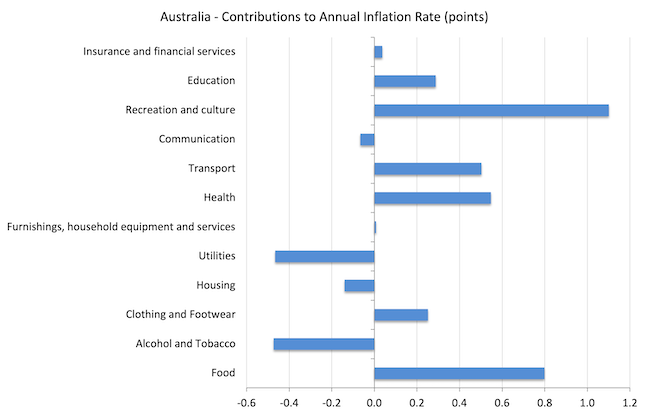
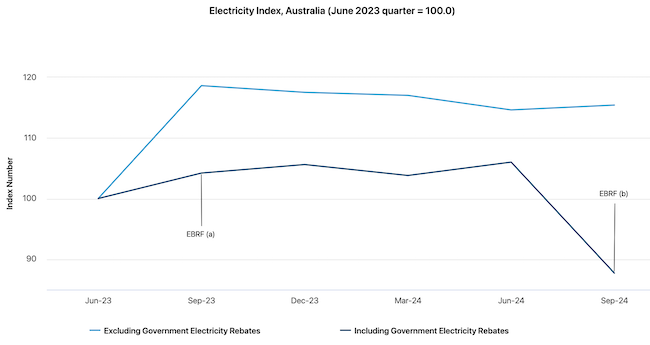
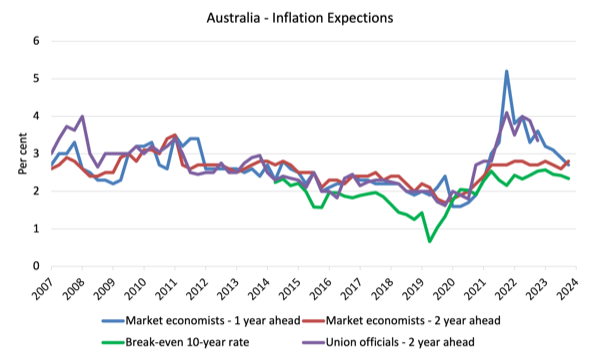
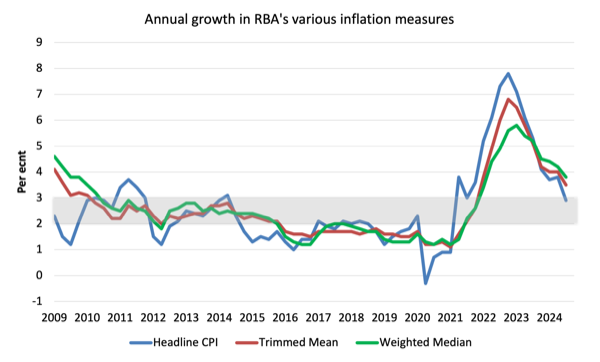
Consumer cost controls = an inflation management tool. How original.
“Utilities is a sub-group of Housing and are significantly impacted by government administrative decisions, which allow the privatised companies to push up prices each year, usually well in excess of CPI movements.
The impact of fiscal policy on that sub-group via the electricity rebates has obviously been significant, which goes to show that governments can moderate inflation through expansionary fiscal policy if the drivers are from the supply-side.”
In this case inflation was countered by a flow-through payment to the gougers via a rebate from the public purse that notionally passed through the hands of consumers. N.B. that is a one-off exercise as it still leaves the gouging prices in place for next time. Is it done again to keep making the suppliers wealthier or do we do something extra to reign in that wealth transfer?
Now the trick is to apply it to the supply side by limiting their capacity to price gouge. If we are to ever attempt to seriously deal with ecological overshoot then price controls must be in the armoury.
Food inflation remains high, even if, in average, the rates are going down.
When food production, distribution and selling is increasingly in the hands (and pockets) of 3 or 4 monopolist hedge funds, we can expect them to rule over inflation and not the (weak) governments we pretend to elect.
In fact, we don’t elect anything.
We are given the chance to choose between the two faces of the same coin.